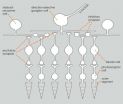(Press-News.org) A team of researchers from the United States and Europe has identified a single genetic mutation in the CUBN gene that is associated with albuminuria both with and without diabetes. Albuminuria is a condition caused by the leaking of the protein albumin into the urine, which is an indication of kidney disease.
The research team, known as the CKDGen Consortium, examined data from several genome-wide association studies to identify missense variant (I2984V) in the CUBN gene. The association between the CUBN variant and albuminuria was observed in 63,153 individuals with European ancestry and in 6,981 individuals of African American ancestry, and in both the general population and in individuals with diabetes. The findings are published in the March 2011 edition of JASN.
Chronic kidney disease is a serious public health problem in the U.S. and around the world. Characterized by reduced kidney function or kidney damage, the disease affects approximately 10 percent of adults in the U.S. Elevated levels of urinary albumin (albuminuria) are a cardinal manifestation of chronic kidney disease. Higher levels of albuminuria, even within the low normal range, are associated with not only increased risks of end-stage renal disease, requiring kidney transplant or dialysis, but also cardiovascular disease and mortality.
Important risk factors for chronic kidney disease include diabetes and hypertension, although kidney disease clusters in families. The hereditary factors underlying chronic kidney disease have been difficult to determine until recently, when new methods to search for risk genes became available. The CKDGen Consortium applied one of the new methods, called genome-wide association study. In 2008, Johns Hopkins researchers used similar methods to identify common variants for non-diabetic end-stage renal disease, gout and sudden cardiac death.
"The significance of this finding is that even though the field has known about cubilin (the protein encoded by CUBN) function from experimental animal studies, our study was the first to establish the link between a genetic variation in this gene and albuminuria," said Linda Kao, PhD, MHS, associate professor in the Johns Hopkins Bloomberg School of Public Health's departments of Epidemiology and Biostatistics, and the senior Johns Hopkins author on the study. "The identification of CUBN and its association with albuminuria will lead to a multitude of follow-up work that will help us begin to understand the mechanism behind albuminuria and, hopefully, will ultimately lead to novel treatment targets."
###
Participating CKDGen Consortium studies include: Age, Gene/Environment Susceptibility Reykjavik Study (AGES); the Amish Study; the Atherosclerosis Risk in Communities Study (ARIC); the Austrian Stroke Prevention Study (ASPS); the Baltimore Longitudinal Study of Aging (BLSA); the Cardiovascular Health Study (CHS); the Erasmus Rucphen Family Study (ERF); the Family Heart Study (FamHS); the Framingham Heart Study (FHS); the Genetic Epidemiology Network of Atherosclerosis (GENOA); the Gutenberg Heart Study; the Health, Aging and Body Composition Study (HABC); the Health Professionals Follow-Up Study (HPFS); the Kooperative Gesundheitsforschung in der Region Augsburg (KORA); the Korcula Study; the Micros Study; the Nurses' Health Study (NHS); the Northern Swedish Population Health Study (NSPHS); the Orkney Complex Disease Study (Orcades) Study; the PopGen Study; the Rotterdam Study (RS); the Swiss Cohort Study on Air Pollution and Lung and Heart Diseases in Adults (SAPALDIA); the Salzburg Atherosclerosis Prevention program in subjects at High Individual Risk (SAPHIR); the Study of Health in Pomerania (SHIP); the Sorbs Study; the Split Study; the Vis Study; and the Women's Genome Health Study (WGHS) Study, as well as the Cohorts for Heart and Aging Research in Genome Epidemiology (CHARGE) Consortium.
The research was funded by the National Heart, Lung and Blood Institute and the National Institute of Diabetes and Digestive and Kidney Diseases of the U.S. National Institutes of Health, the Icelandic Heart Association and the Icelandic Parliament, the German Research Foundation, the Netherlands Organization for Scientific Research and the Netherlands Heart Foundation, and the European Commission.
Gene variant influences chronic kidney disease risk
2011-03-10
ELSE PRESS RELEASES FROM THIS DATE:
New microscope decodes complex eye circuitry
2011-03-10
VIDEO:
Ganglion cells preferentially form synapses with those amacrine cells whose dendrites run in the direction opposite -- seen from the ganglion cell - to the preferred direction of motion (amacrine...
Click here for more information.
The sensory cells in the retina of the mammalian eye convert light stimuli into electrical signals and transmit them via downstream interneurons to the retinal ganglion cells which, in turn, forward them to the brain. The interneurons ...
Physicists measure current-induced torque in nonvolatile magnetic memory devices
2011-03-10
ITHACA, N.Y. - Tomorrow's nonvolatile memory devices – computer memory that can retain stored information even when not powered – will profoundly change electronics, and Cornell University researchers have discovered a new way of measuring and optimizing their performance.
Using a very fast oscilloscope, researchers led by Dan Ralph, the Horace White Professor of Physics, and Robert Buhrman, the J.E. Sweet Professor of Applied and Engineering Physics, have figured out how to quantify the strength of current-induced torques used to write information in memory devices ...
NASA and other satellites keeping busy with this week's severe weather
2011-03-10
Satellites have been busy this week covering severe weather across the U.S. Today, the GOES-13 satellite and NASA's Aqua satellite captured an image of the huge stretch of clouds associated with a huge and soggy cold front as it continues its slow march eastward. Earlier this week, NASA's Tropical Rainfall Measuring Mission satellite captured images of severe weather that generated tornadoes over Louisiana.
Today the eastern third of the U.S. is being buffered by a large storm that stretches from southeastern Minnesota east to Wisconsin and Michigan, then south through ...
International panel revises 'McDonald Criteria' for diagnosing multiple sclerosis
2011-03-10
International Panel Revises "McDonald Criteria" for Diagnosing MS -- Use of new data should speed diagnosis -- Publication coincides with MS Awareness Week
An international panel has revised and simplified the "McDonald Criteria" commonly used to diagnose multiple sclerosis, incorporating new data that should speed the diagnosis without compromising accuracy. The International Panel on Diagnosis of MS, organized and supported by the National MS Society and the European Committee for Treatment and Research in Multiple Sclerosis, was chaired by Chris H. Polman, MD, PhD ...
MIT scientists identify new H1N1 mutation that could allow virus to spread more easily
2011-03-10
CAMBRIDGE, Mass. -- In the fall of 1917, a new strain of influenza swirled around the globe. At first, it resembled a typical flu epidemic: Most deaths occurred among the elderly, while younger people recovered quickly. However, in the summer of 1918, a deadlier version of the same virus began spreading, with disastrous consequence. In total, the pandemic killed at least 50 million people — about 3 percent of the world's population at the time.
That two-wave pattern is typical of pandemic flu viruses, which is why many scientists worry that the 2009 H1N1 ("swine") flu ...
New study proves the brain has 3 layers of working memory
2011-03-10
Researchers from Rice University and Georgia Institute of Technology have found support for the theory that the brain has three concentric layers of working memory where it stores readily available items. Memory researchers have long debated whether there are two or three layers and what the capacity and function of each layer is.
In a paper in the March issue of the Journal of Cognitive Psychology, researchers found that short-term memory is made up of three areas: a core focusing on one active item, a surrounding area holding at least three more active items, and a ...
Giving children the power to be scientists
2011-03-10
Children who are taught how to think and act like scientists develop a clearer understanding of the subject, a study has shown.
The research project led by The University of Nottingham and The Open University has shown that school children who took the lead in investigating science topics of interest to them gained an understanding of good scientific practice.
The study shows that this method of 'personal inquiry' could be used to help children develop the skills needed to weigh up misinformation in the media, understand the impact of science and technology on everyday ...
Researchers selectively control anxiety pathways in the brain
2011-03-10
A new study sheds light--both literally and figuratively--on the intricate brain cell connections responsible for anxiety.
Scientists at Stanford University recently used light to activate mouse neurons and precisely identify neural circuits that increase or decrease anxiety-related behaviors. Pinpointing the origin of anxiety brings psychiatric professionals closer to understanding anxiety disorders, the most common class of psychiatric disease.
A research team led by Karl Deisseroth, associate professor of psychiatry and behavioral sciences and bioengineering, identified ...
Researchers develop synthetic compound that may lead to drugs to fight pancreatic, lung cancer
2011-03-10
DALLAS – March 10, 2011 – Researchers at UT Southwestern Medical Center have identified a chemical compound that may eventually lead to a drug that fights cancers that are dependent on a particular anti-viral enzyme for growth.
The researchers are testing the compound's effectiveness at fighting tumors in mice. If it is successful, they will then work to develop a drug based on the compound to combat pancreatic and non-small cell lung cancer, two cancer types in which this particular enzyme, TBK-1, often is required for cancer cell survival.
"Our prediction is that ...
Report: International collaboration between researchers results in greater recognition
2011-03-10
U.S. researchers who collaborate with international scientists are more likely to have their work cited than peers who do not utilize overseas expertise, according to a new study released this week by Rice University's Baker Institute for Public Policy. U.S. collaborators with international scientists are also more likely to receive greater recognition and produce work with greater impact.
The study, "International Stem Cell Collaboration: How Disparate Policies Between the United States and the United Kingdom Impact Research," was authored by Kirstin Matthews, a fellow ...


